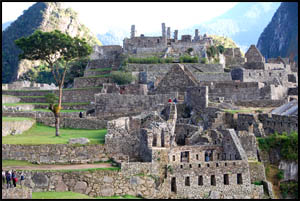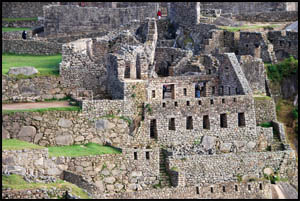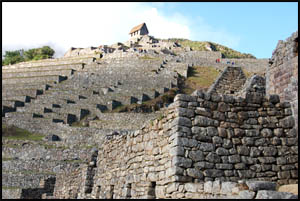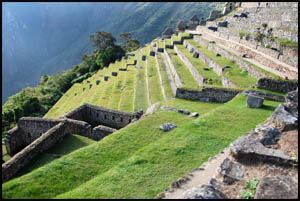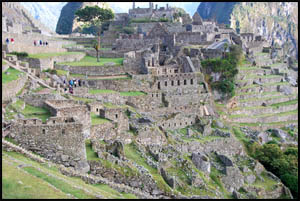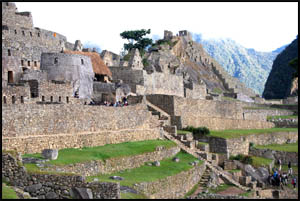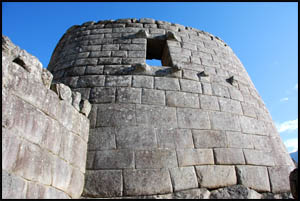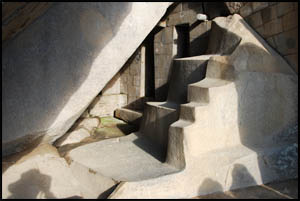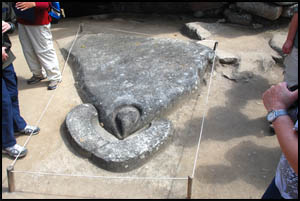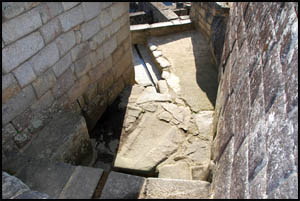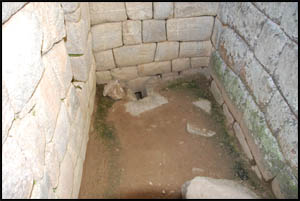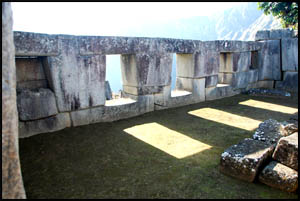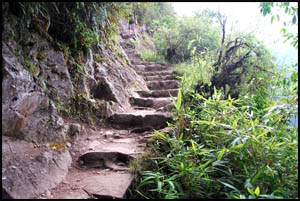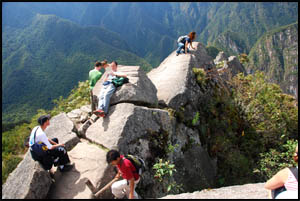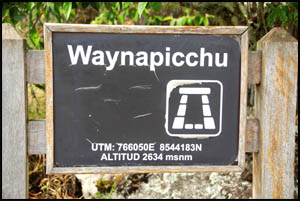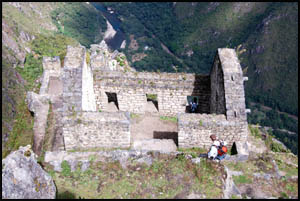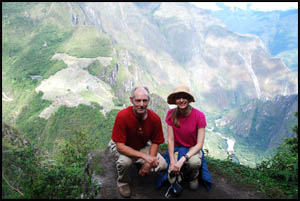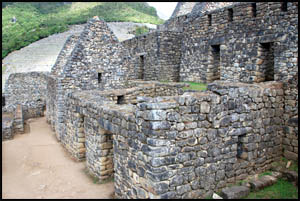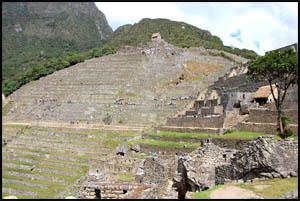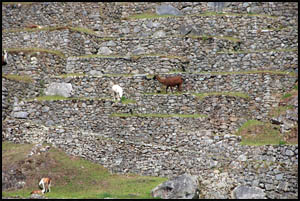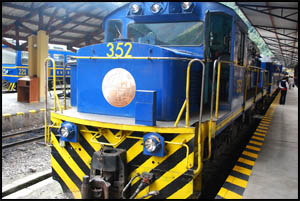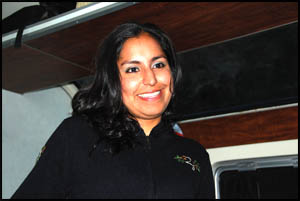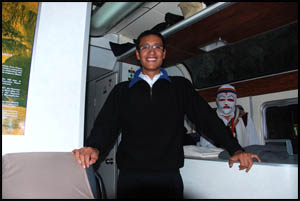We are up at 5:00 so we can pack, eat, and meet Ruben at the bus stop at 6:30 for our tour of Machu Picchu. The ride takes thirty minutes up to the ruins. The entrance has a plaque dedicated to Hiram Bingham, the Yale University professor and archeologist, who discovered Machu Picchu in 1911. We begin our tour with a walk into the middle of Machu Picchu. A group of buildings near the top is called the High Group. They were also known as the Northern Neighboorhood. Priests or people of high stature probably lived there. The terracing is impressive. Since this place is huge, construction of the terrace walls must have taken years. I am amazed that the terraces are so uniform and precise. It is difficult to describe the majesty and beauty of this place, so pictures do it best. The High Group, Temple of the Sun, and numerous terraces are shown below.
Ruben explains that the huge, semi-circle rock structure below was a special temple, the Temple of the Sun. It is considered one of the most beautiful buildings in Machu Picchu. The Incas incorporated its construction into the massive natural stone at its base. One of the windows in the Temple is precisely placed so that a beam of sunlight is focused on the floor only at dawn during the winter solstice, June 21. True to Inca construction, the window near the top is trapezoidal in shape. The top and bottom stones of the window shown have unusual knobs at the corners, something historians are at a loss to explain.
Beneath the Temple of the Sun is the Royal Tomb or Royal Chamber. It is carved into the solid stone base of the Temple of the Sun. Hiram Bingham gave it this name even though no human remains were ever found in it. Some believe it may have been a place to worship or give offerings to particularly important mummies. The Incas apparently revered the condor and built a stone image of one beside the Royal Tomb and next to the Temple of the Sun.
In the upper part of the passageway picture below, you can see what appears to be a pipe. It is actually a semi-circle cut into the solid stone base to carry water, much like a pipe would. The upper half would also have been solid stone with the same semi-circle cut out. The Incas had running water in all of Machu Picchu. Their bedrooms were small and they slept on the floor, probably on pads or straw. They had sewage disposal facilities in their bathrooms, although they were required to squat, similar to what we saw in the bathrooms on the trail.
The Sacred Plaza, in the lower center of the first picture below, is where religious ceremonies were carried out. There are numerous unused large stones laying around on the other side of the Sacred Plaza. This indicates that Machu Picchu was unfinished when the Incas abandoned it, probably because of earthquakes and partial building collapses. On the side of the Sacred Plaza is the Temple of the Three Windows. It was one of the more significant buildings in Machu Picchu and was also used for ceremonial purposes.
Several of us want to climb Wayna Picchu, the high mountain next to Machu Picchu. The authorities only allow 400 people each day to make the climb. We get in line at 8:30 and find that they have instituted additional restrictions of waiting until the first 200 people return. At 9:30 we are finally allowed to proceed, but only after signing a log book so they can insure that we make it out. The climb is extremely steep, almost vertical. Beth and James quickly leave me behind. In about an hour, I approach the top where the views of Machu Picchu far below are incredible.
There is a small cave/passageway that you must crawl through to go farther. After a little mild scrambling, I climb up on some boulders at the very top. To reiterate Ann's statement from the top of Dead Woman's Pass on Day Two, that climb was a bitch. The views are fantastic. I make my way around to the other side and find a sign signifying the top. The remains of the Temple of the Moon, also known as the Palace of the Moon, are here too. I wonder how the Incas got all the building materials up here.
The path down from the top starts out on some extremely steep and narrow steps. Their steepness requires you to either back down or turn sideways when going down to keep from falling. Unlike many of the sections going uphill, these steps do not have a handrail. I wonder why the authorities don't have this as the way up since these steps would be much easier going up instead of down. I meet Beth and James in a few minutes. James takes our picture with Machu Picchu in the background.
The trip down is considerably less strenuous than the climb up. We sign out in the log book at the entry station, meet with our group, and continue the tour with Ruben. Normally you would think that maintenance of the grassy areas on the numerous terraces would be problematic for the caretakers of Machu Picchu. However, they solved this issue by allowing llamas to roam freely on the terraces and eat the grass. We meet at the entrance and take the bus down to Aguas Calientes. We are going part way back to Cusco by train, something I haven't been on since I was a kid. The Perurail train is a narrow gauge railroad, much like the old mining trains were in Colorado. In mountainous terrain, it is considerably cheaper to build narrow gauge track with rails three feet six inches wide opposed to building standard gauge track with rails at four feet eight and one-half inches wide.
Our two railroad cars have three attendants. Alpaca sweaters are very popular items for tourists to buy while in Peru, so our attendants put on a fashion show for the passengers during our ride and actually sell some of the sweaters. They are quite expensive.
We get off the train at Ollantaytambo and take the van the rest of the way back to Cusco. This evening we have a celebration supper with Ruben at the hotel where we each give him a tip for all his hard work the last week. MAIN INDEX | HIKING INDEX | BACK TO DAY 4 | FORWARD TO POSTSCRIPT
|


